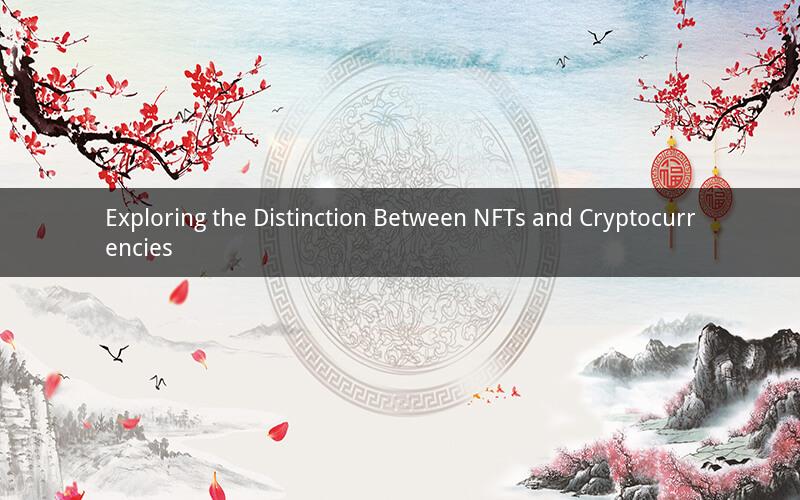
NFTs, or Non-Fungible Tokens, and cryptocurrencies are both innovative technologies that have gained significant attention in the digital realm. Despite their shared characteristics, they differ fundamentally in their nature and usage. In this article, we will delve into the differences between NFTs and cryptocurrencies, highlighting their unique features and exploring their respective roles in the digital economy.
1. Definition and Nature
Cryptocurrencies are digital or virtual currencies that use cryptography for security. They are designed to be decentralized, meaning they are not controlled by any central authority, such as a government or financial institution. Cryptocurrencies, like Bitcoin and Ethereum, are fungible, which means that each unit is interchangeable with another unit of the same currency.
On the other hand, NFTs are unique digital assets that cannot be exchanged on a one-to-one basis like cryptocurrencies. Each NFT represents a distinct piece of content, such as an artwork, a collectible, or a digital asset. Unlike cryptocurrencies, NFTs are non-fungible, making them scarce and valuable.
2. Usage and Applications
Cryptocurrencies are primarily used as a medium of exchange, a store of value, and a unit of account. They allow users to make transactions quickly and securely without the need for a centralized authority. Cryptocurrencies have been widely adopted for online purchases, cross-border payments, and as a hedge against inflation.
NFTs, on the other hand, are used to tokenize unique digital assets, providing ownership and authenticity. They have gained popularity in the art, gaming, and collectibles markets. NFTs enable creators to earn royalties on their work and collectors to own and trade unique digital assets.
3. Blockchain Technology
Both NFTs and cryptocurrencies rely on blockchain technology, a decentralized and secure digital ledger. Blockchain ensures the transparency and immutability of transactions, making them tamper-proof. However, the use of blockchain technology differs between the two.
Cryptocurrencies, like Bitcoin, utilize blockchain technology to facilitate transactions and maintain a secure, decentralized ledger. In contrast, NFTs are built on top of existing blockchain platforms, such as Ethereum, to create and manage unique digital assets.
4. Scarcity and Ownership
One of the key distinctions between NFTs and cryptocurrencies is the concept of scarcity and ownership. Cryptocurrencies are designed to be abundant, with a finite supply. For example, Bitcoin has a maximum supply of 21 million coins, while Ethereum has no maximum supply.
In contrast, NFTs are scarce, as each NFT represents a unique asset. This scarcity adds value to NFTs, making them desirable for collectors and investors. Ownership of an NFT is also distinct from that of a cryptocurrency, as it is tied to a specific digital asset rather than a currency.
5. Market and Investment Potential
The market and investment potential of NFTs and cryptocurrencies vary significantly. Cryptocurrencies have been the subject of intense debate and have experienced substantial price fluctuations. Some investors have made substantial profits, while others have suffered significant losses.
NFTs, on the other hand, have seen a surge in interest and investment, with record-breaking sales and auction prices. The NFT market has attracted a diverse range of investors, including artists, collectors, and entrepreneurs. However, the market remains relatively young and unpredictable, with potential risks and uncertainties.
6. Conclusion
In conclusion, NFTs and cryptocurrencies are distinct technologies with unique features and applications. While cryptocurrencies are primarily used as a medium of exchange and a store of value, NFTs tokenize unique digital assets, providing ownership and authenticity. Understanding the differences between the two is crucial for investors, creators, and enthusiasts navigating the digital economy.
Questions and Answers:
1. What is the primary difference between NFTs and cryptocurrencies?
Answer: The primary difference is that NFTs are non-fungible and represent unique digital assets, while cryptocurrencies are fungible and used as a medium of exchange.
2. Can NFTs be used as a medium of exchange?
Answer: While NFTs can be used to facilitate transactions, they are not commonly used as a medium of exchange like cryptocurrencies.
3. Are NFTs more secure than cryptocurrencies?
Answer: Both NFTs and cryptocurrencies rely on blockchain technology for security. However, NFTs are subject to the same security risks as the blockchain platform they are built on.
4. Can NFTs be used as a hedge against inflation?
Answer: NFTs can be used as an investment, but they are not specifically designed as a hedge against inflation like cryptocurrencies.
5. Are NFTs more valuable than cryptocurrencies?
Answer: The value of NFTs and cryptocurrencies varies greatly. While some NFTs have fetched record-breaking prices, the overall market for NFTs is relatively small compared to the cryptocurrency market.